Your Android tablet sucks. At least compared with what’s coming. Later this year we’ll see the release of three new Systems on Chip (SoC). SoC is simply the name used for the collection of silicon that makes up the brains of the tablet and includes the CPU, GPU (graphics processing unit), onboard memory, and other processors.
The new chips will no doubt be used to power many high-end Android tablets and are expected to deliver better-looking games, faster Web surfing, increased battery life, and in at least one case, could allow you to take better-looking photos.
Of course, these chips have yet to see the light of day on tablets, so I can’t say with certainty the benefits they’ll provide, but I’m willing to go out on a limb to say they’ll be faster and more power efficient than your soon-to-be older chips. And over the next several paragraphs, I’ll detail why.
Samsung Exynos 5 Octa
Since the debut of the Samsung Galaxy Tab 7 Plus, the company has pretty much stuck with its proprietary Exynos SoC for most of its tablets. The latest Exynos is the 5 Octa, which derives its name from the inclusion of eight CPU cores. A first for any ARM processor.
However Samsung hasn’t just thrown in a bunch of cores to inflate the chip’s performance, but is instead looking to establish new levels of power/performance efficiency. In other words, Samsung wants to make your tablet’s battery last longer without gimping the device’s speed.
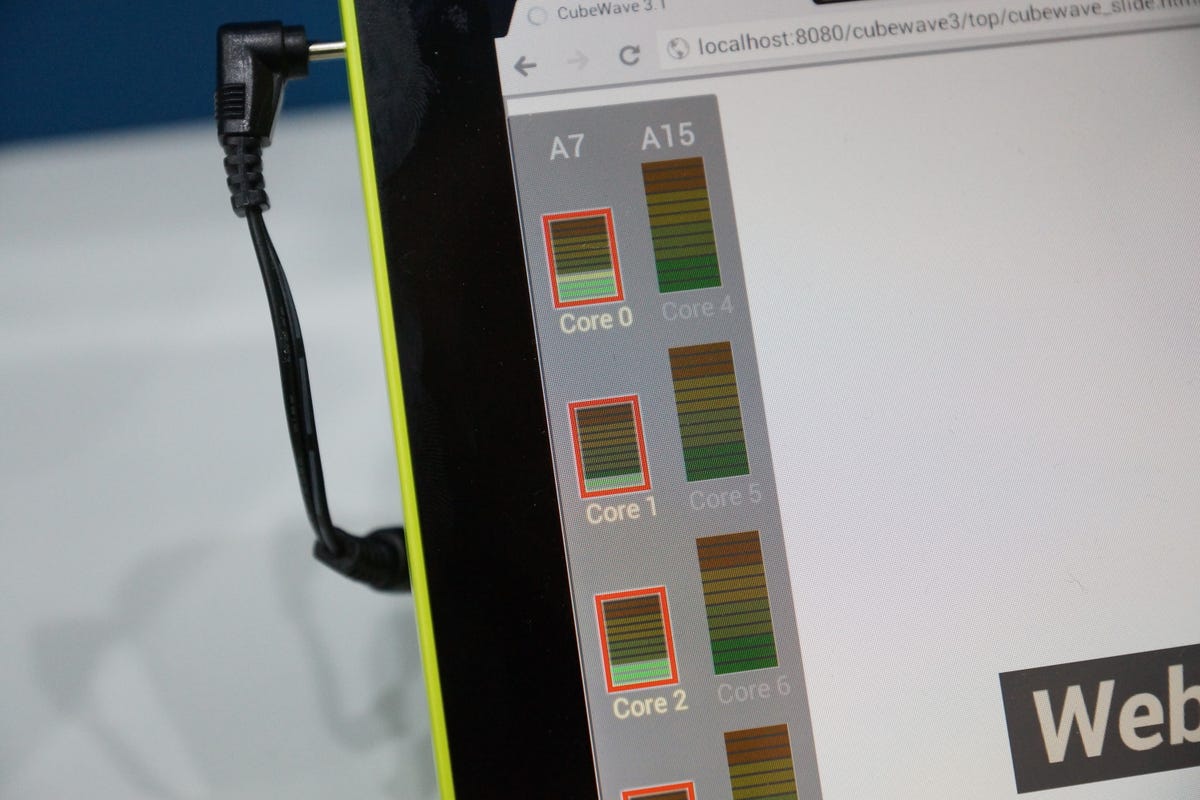

Eric Franklin/CNET
Tablet and smartphone SoCs, like the Exynos 5 Dual in the Nexus 10, have recently started using processors based on ARM’s Cortex-A15 architecture. “Cortex” is simply the designation given to a line of ARM’s mobile chips and the “AXX” number simply refers to the chips’ relative power. The higher the “AXX” number, the more efficient and powerful you can expect the chip to be.
The Octa houses two CPUs; a Cortex-A15 chip built for performance, and a low-power Cortex-A7 CPU. Each CPU includes four cores and according to Samsung, the Octa will seamlessly switch between cores, depending on the task at hand. So, if you’re playing a demanding game or recording video, the higher performing Cortex-A15 cores will be put to task; however, for simple Web browsing, e-mail, or playing music, the low-power A7 CPU would take over. The other cores would then power down to await their next highly-taxing task.


Sarah Tew/CBS Interactive
According to Samsung, pairing these low-power cores with four others built for performance, yields more than 70 percent more battery life than if it had simply gone with eight high-performing cores. It also says that compared with previous Exynos processors, Octa provides 70 percent better CPU performance while delivering 20 percent more battery life. It doesn’t, however, specify which Exynos processors it used for the comparison.
As for game performance, the Octa uses a triple-core PowerVR SGX544MP3. Going simply by its model name, this GPU should deliver performance somewhere between the iPhone 5 and iPad 4, which feature the SGX543MP4 and SGX554MP4, respectively. That’s just a personal estimate, of course, but if I’m right, that puts the Octa at about a Nexus 10 graphics performance level. And though the Nexus 10 currently delivers the best Android games performance, I’m personally hoping for something a bit more powerful.
The Octa also supports USB 3.0 for faster file transfers and quicker charging and an advanced image signal processor (ISP) that purportedly has zero shutter lag.
What to expect: The Exynos 5 Octa should provide good performance while delivering long battery life, thanks to its four low-power cores. Games performance will likely be a bit better than what’s available on the Nexus 10.
When will we see it? In many non-U.S. markets, the 5 Octa will debut in the Samsung Galaxy S4 and while we could see it in the rumored Samsung Galaxy Tab 3, nothing has been announced.
Qualcomm Snapdragon 800
The Snapdragon 600 SoC is available in the LG Optimus G Pro. The 600 includes a quad-core Krait 300 CPU and an Adreno 320 GPU, both of which as you can see below already prove to be impressively fast processors. These results were taken from a normal (1,280×720-pixel resolution) run of 3DMark; a synthetic benchmark that tests both CPU and GPU performance. Just in case you’re wondering, there’s currently no iPad version of the benchmark.
The results are presented in frames per second (fps), with the higher number indicating better performance. GPU performance essentially measures how pretty your games will look, while CPU performance is more overall system speed and comes into play when launching apps or something highly computational like encoding or recording video.
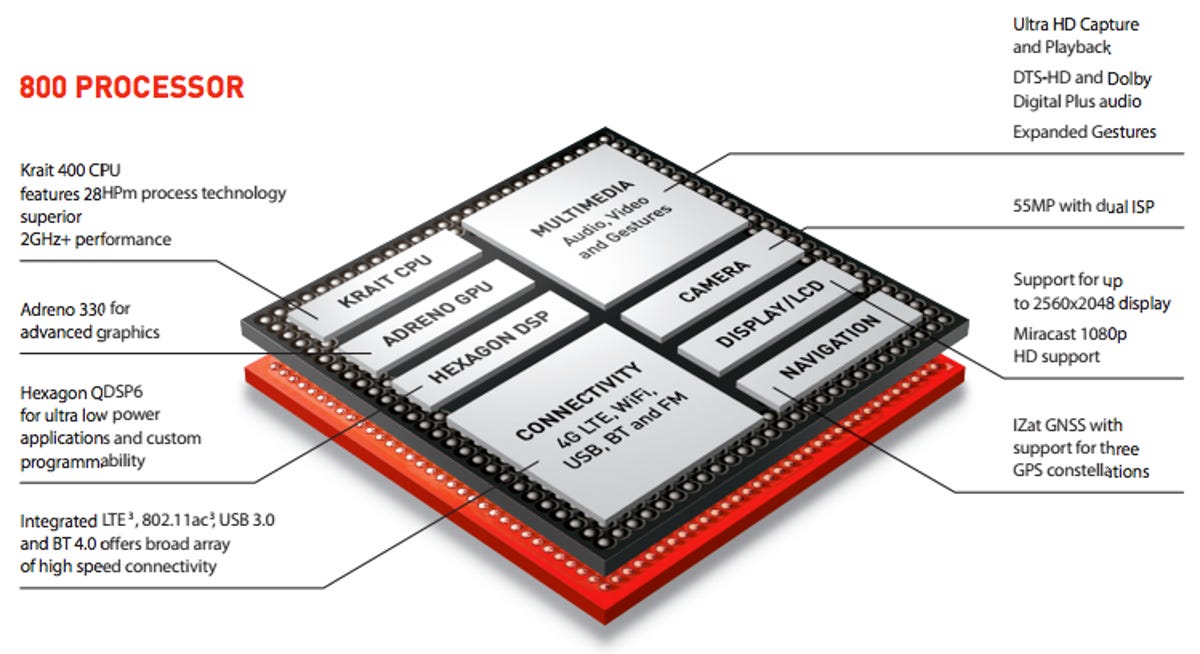

Qualcomm
As you can see, the Snapdragon 600 inside the Optimus G Pro is clearly faster in both CPU and GPU speed compared with two of the fastest Android tablets.
table.geekbox th{background-color:#E6ECEF;text-align:left;font-weight:bold;}
table.geekbox tr.even{background-color:#CCCCCC;}
.ratingGood{color:#093;} .ratingAverage{color:#666;} .ratingBad{color:#C00;}
| CPU performance | GPU performance | |
|---|---|---|
| Samsung Galaxy Note 8-1.6GHz quad-core Exynos 4 Quad (4412) | 34.2fps | 8.7fps |
| Google Nexus 10-1.7GHz Dual-core Samsung Exynos 5 Dual (5250) | 26.2fps | 36.9fps |
| LG Optimus G Pro-1.7GHz quad-core Qualcomm Snapdragon 600 | 41.8fps | 40.6fps |
The Snapdragon 800 will sport a faster CPU and GPU (the Krait 400 and Adreno 330, respectively), which means faster app loads and navigation, smooth HD video, and faster Web surfing. Also, according to Qualcomm, the Snapdragon 800 should provide 50 percent more GPU performance compared with the 600, and the chip will also support up to 55-megapixel cameras and will feature a more accurate GPS and a built-in 3G/4G LTE modem. The SoC will offer battery life efficiency through a low-power processor that will run less demanding tasks.
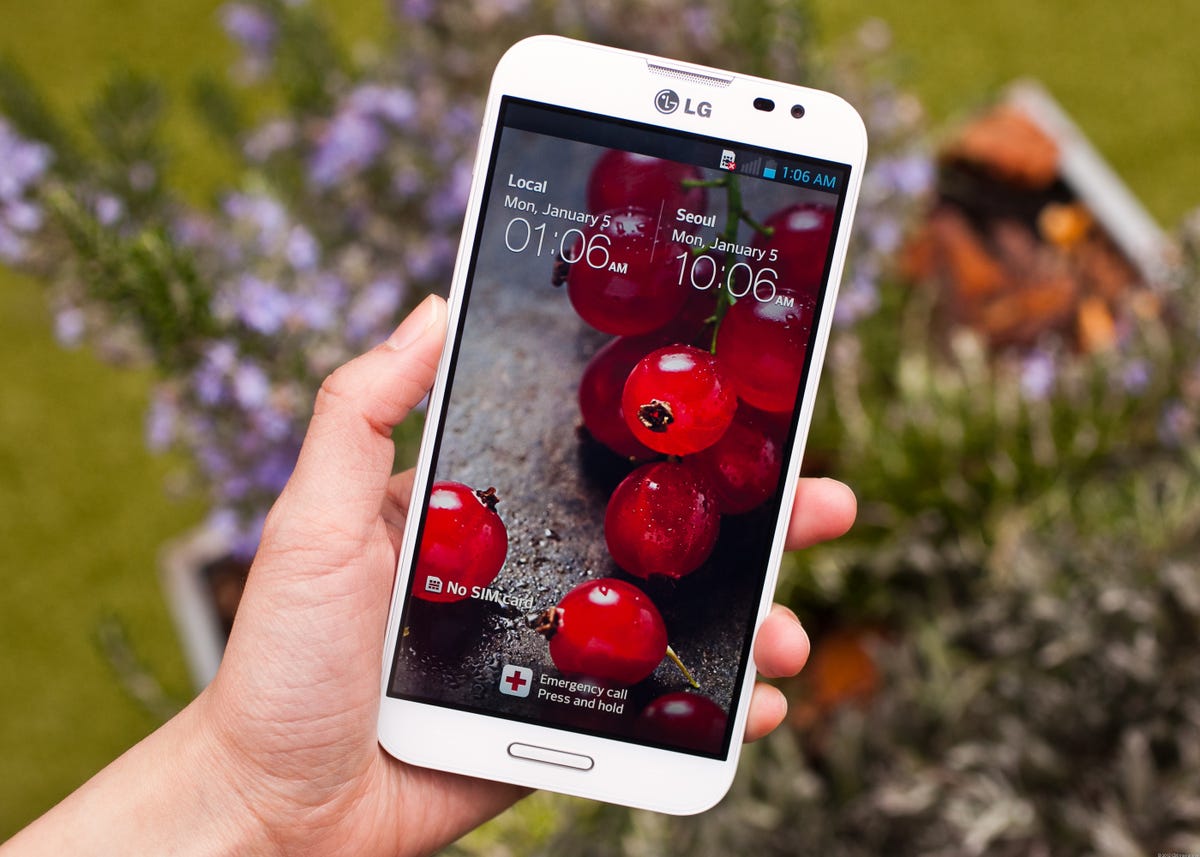

Josh Miller/CNET
The SoC also has the capability to both capture and playback 4K- and 2K-resolution video, although there’s no guarantee that every device housing the chipset will include this capability. USB 3.0 will deliver faster file transfers as well as quicker battery charging. Unfortunately, no tablets as yet have been announced to be using the SoC.
What to expect: Expect the Snapdragon 800 to deliver graphics on a level we’ve yet to see on Android while also providing a noticeably zippier navigating experience, with fast app-loading and smooth HD movie playback.
When will we see it? Both the Nexus 7 2 and Nexus 5 are rumored to house the new SoC, but as yet no device has been confirmed to being using the powerful new SoC.
Nvidia Tegra 4
Nvidia’s Tegra 4 SoC will feature four high-performing Cortex A-15 cores and a single Cortex A-15 battery saver core for low-demand tasks. A similar setup to the Octa, but with less CPU cores being used. According to Nvidia, Tegra 4 will offer significantly more power savings and higher performance than Tegra 3, which translates into faster Web browsing, app launching, and much prettier games, while continuing to extend battery life.
What’s really impressive, however — at least from an architecture perspective — are the 72 –seven, two — GPU cores the Tegra 4 utilizes, which is by far, the most of any ARM-based processor. With 72 cores devoted to graphical computations, we should be expecting higher frame rates, more detailed graphics, and advanced effects like self-shadowing — where an object’s shadow casts on itself as well as the surrounding environment — without the frame rate dropping like a ton of bricks.
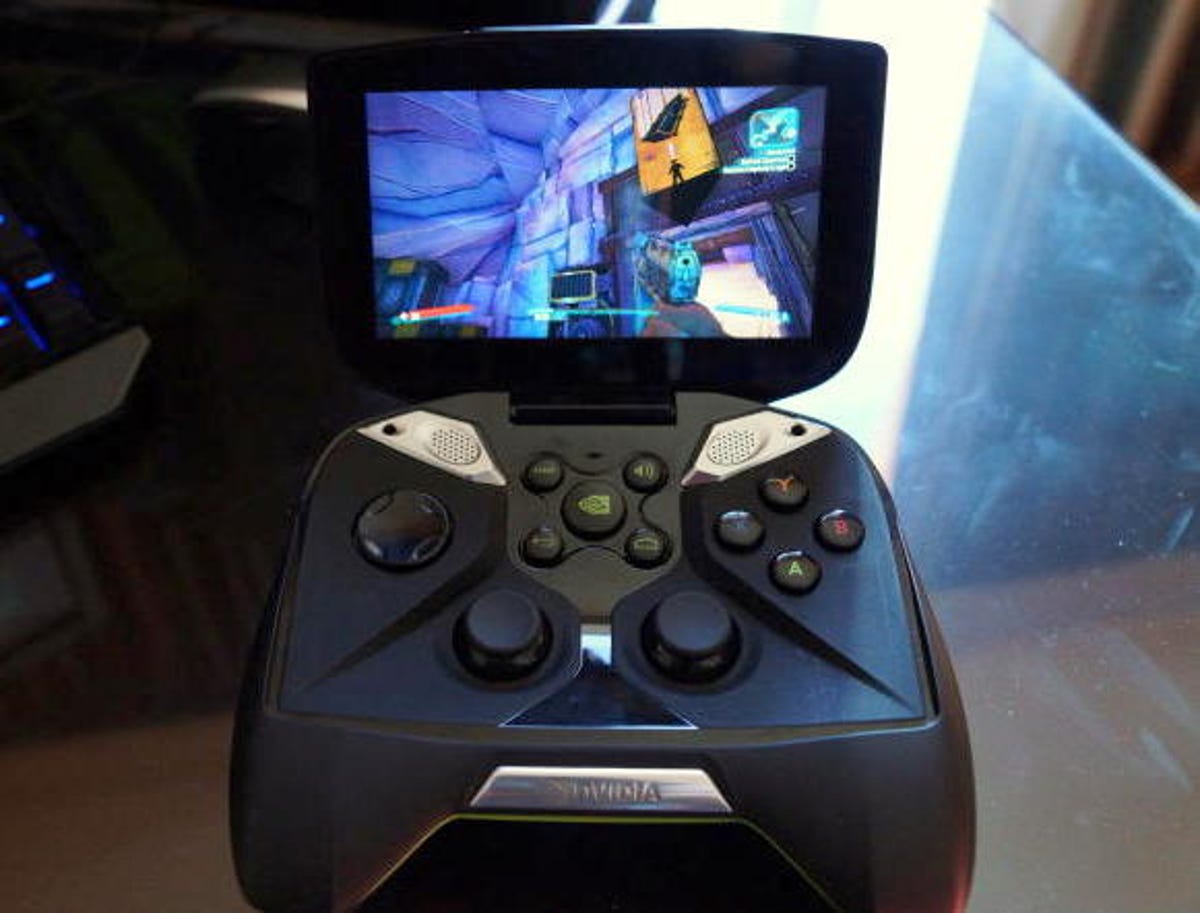

Eric Franklin/CNET
However, theoretical performance based on specs and actual real-world performance are all-too-often two different things. Nvidia’s own Project Shield is set to be one of the first Tegra 4 devices and while the Hawken demo I saw on the device at CES earlier this year was impressive, other game demos I’ve since been exposed to were less so.
A few weeks ago at GDC, I got a chance to briefly play around with an unfinished Riptide GP 2 on Shield and while the character models, water effects, and those aforementioned self-shadows were all out in abundance and impressive, the frame rate was disappointingly low. I’ll, of course, reserve judgment until I experience both the final version of the game running on final hardware, but my enthusiasm has been somewhat curtailed.
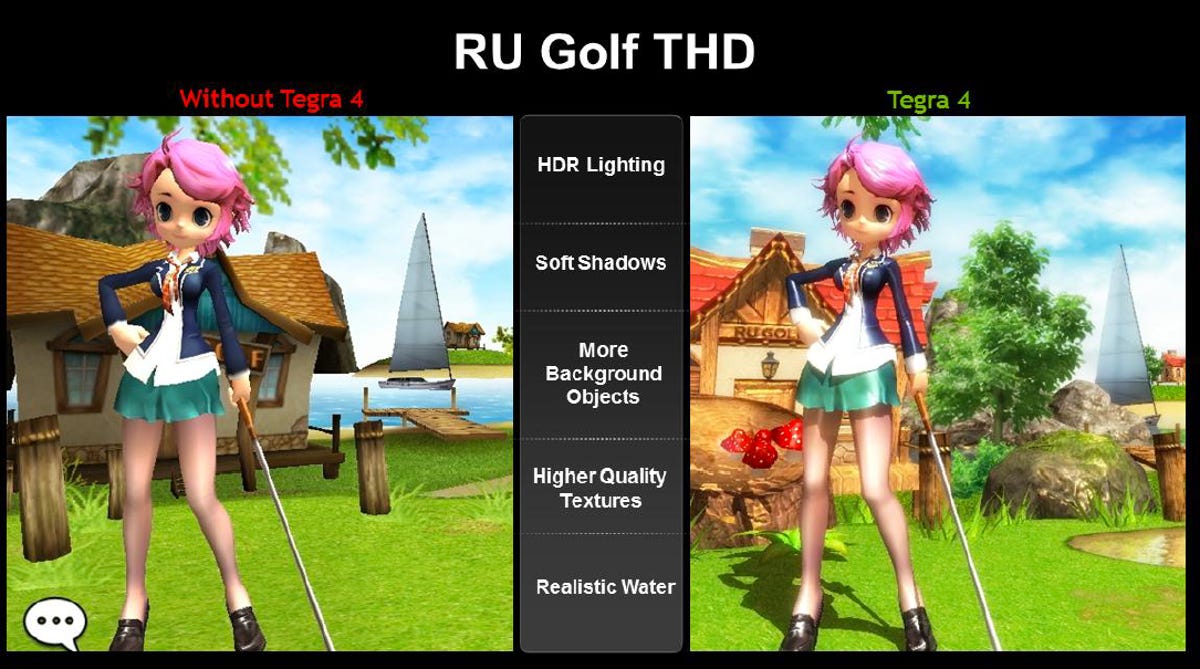

Nvidia
It should be noted, however, that according to results from Nvidia and Anandtech, running the synthetic benchmark, GLBenchmark 2.5, Tegra 4 has delivered impressive results, even keeping up with the iPad 4 (according to internal testing I’ve done). Once we have Tegra 4 devices I’ll be sure to put them through deep and thorough testing.
The Tegra 4 will also support up to 3200×2000 resolution screens and output up to a 4K-resolution signal through HDMI.
HDR for photos
However, it’s not only gamers and speed freaks that’ll see benefits from Tegra 4’s many GPU cores. Nvidia seeks to put those cores to use in myriad ways.
First off, the Tegra 4 will have built-in near-real-time high dynamic range (HDR) support for both still shots and video. HDR photography is a way to balance a picture that features both harsh sunlight and detail-blotting shadows. With HDR, a camera takes multiple shots of the same scene, each at a different exposure. A software algorithm then interpolates those shots, creating one new, balanced shot showcasing both the bright parts and dark parts with appropriate detail.


Nvidia
HDR is nothing new, of course. The iPhone has had it for a couple of years now, but even on the iPhone 5, the process takes about 2 seconds to complete on still photos and isn’t available for video. A lot of movement can occur within those two seconds and in cases when a foreground object is in focus and there’s a moving background object, graphical artifacts can appear when snapping an HDR pic.
Tegra 4 attempts to leverage its multicore GPU, its CPU, and a new custom-built image signal processor (ISP) to significantly speed up the HDR process by taking two shots very quickly. Nvidia claims HDR processing up to 10 times faster than the iPhone 5’s; about 0.2 second. It will also be able to apply its fast processing to capturing HDR 1080p video at 30 frames per second, HDR burst mode (taking several shots in quick succession), HDR panorama, and HDR with flash enabled — all features currently not seen on even the iPhone 5.


Nvidia
What this will hopefully amount to is a group of devices where having HDR turned on at all times isn’t a speed liability. When it comes time to quickly capture a desired shot, the Tegra 4 should be able to not only do it quickly, but also do it well.
What to expect: Expect the Tegra 4 to have the best overall graphics performance of any Android SoC when it’s actually released. Also, all tablets and smartphones using Tegra 4 will have will have its multiple HDR features built-in.
When will we see it? Project Shield is slated to debut in late summer and earlier this year, Vizio announceda new 10-inch Tegra 4 slate. No other official announcements have been made.
The outlook
When it comes to graphical performance, the iPad 4 still outpaces the Nexus 10, and while the Nexus 10 delivers higher theoretical CPU speed, the iPad 4 still delivers a smoother, zippier tablet experience. However, 2013 may just be the year that Apple finally loses its performance dominance; the new Android SoCs featured here are just the tip of the iceberg.
It’s not just the silicon that matters, but the software is just as important. The release of Android 4.2.2 included optimizations that significantly improved the performance — especially graphics performance — of both the Nexus 10 and Nexus 7, according to results from synthetic benchmarks like GLBenchmark 2.5.
Android 5.0 or Key Lime Pie is expected to be announced next month, and if the revisions made to Android 4.2.2 are any indication, expect even smoother graphics performance on tablets that run the new OS.
So what does this all mean? Apple will face stiff performance competition this year from a new crop of Android processors and Google’s new OS. However, don’t expect it to take this lying down. The iPad 5 is rumored to release later this year, and the company has a reputation for staying at the head of the pack when it comes to performance.
Regardless of who comes out on top, with such a hard performance push, consumers are surely in a position to reap the benefits of faster speeds and more battery life.



